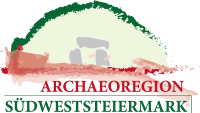The municipality of Wildon is located in a core area of Styrian history on the middle Mur and Kainach rivers, whose earliest Neolithic settlement dates back more than 6,500 years. Since then, almost every cultural epoch has been represented, be it through archaeological finds or historical and art-historically interesting buildings and monuments. Therefore, the Wildon area proves to be an exceptionally rich and multi-layered archaeological finds landscape, even in the European context.
In particular, the Wildon Schlossberg hill, which is very aptly described as a “Styrian history book” in specialist literature, represents a unique finding-place in the entire southeastern alpine region with its several thousand years of settlement continuity. In the 10th and 11th centuries, Hengistburg Castle, located on the Schlossberg, was the center of the Carantanian Mark, which in turn formed the nucleus of present-day Styria. In the 13th century, the ministeriales dynasty of the Wildonians, which formerly resided on the Schlossberg, played a decisive role in shaping Styrian regional politics during the so-called interregnum. Today’s Styrian national colors white-green as well as the foundation of Stainz Abbey can also be traced back to this dynasty.
The extraordinary historical and archaeological significance of the project area as the “cradle of Styria” with regard to the genesis of our province has not yet been adequately used for cultural tourism and presented in museums. The project ArchaeoWild faces exactly this challenge and intends to initiate a sustainable cultural-touristic use of the archaeological heritage (archaeological museum, extended tourism offers) in the infrastructurally extremely favorably situated region (railroad and highway connections). Popularizing, visualizing, and making attractive tangible and intangible archaeological cultural assets opens up a hitherto little exploited potential for tourism and the economy and thus raises the regional economic power.
Work package 1 – Excavation – Evaluation – Traveling exhibition
In spring 2016, a team from the Zentralanstalt für Meteorology and Geodynamik (Central Institute for Meteorology and Geodynamics) Vienna used geoprospecting to detect four to five large, completely eroded burial mounds in the village of Kainach near Wildon. These are noble graves of the Hallstatt-period court society (7th/6th century B.C.). In recent years they have been heavily damaged by agricultural activities. In this work package, scientific excavation and evaluation of the manorial burial mounds using modern documentation techniques (3D scanning) will be undertaken to secure findings for effective cultural and educational tourism use. This activity will last 18 months and its results (finds and features, information, maps and visualizations) will be published on the website of the Kulturpark Hengist (open access; www.hengist-archaeologie.at) as well as made accessible to a broad public in the context of a traveling exhibition “Tatort Archäologie.” The output is a comprehensive, detailed and informative picture of the grave design and the burial customs of upscale Hallstatt-period social classes, which generates added value for tourists.
Work package 2 – Aerial archaeology of southern Styria
This activity includes an archaeological aerial survey of southern Styria (roughly from Wildon to Leibnitz) by the Department of Aerial Archaeology of the Institute of Prehistory and Historical Archaeology (University of Vienna). During these surveys, an archaeologically trained observer searches for archaeological traces from the airplane with naked eyes and documents them from the side window of the airplane with digital cameras. The detected sites are either displayed on maps or – if available – stored in the GPS receiver and later integrated into a geographic information system (GIS) together with the recorded flight path. Subsequently, the recorded aerial photographs are evaluated and interpreted by trained archaeologists using state-of-the-art technologies.
Work package 3 – Museum concept
Based on the archaeological findings in the greater Wildon area, a museum concept will be created as an instrument for a future museum presentation of the archaeological cultural heritage in this region. This visualization of potentials and perspectives for a medium- and long-term development of an archaeological museum in this area will boost the acceptance and secure the success of the later implementation and shall be used as a means of communication towards sponsors, politics, administration and donors. The concept deals with the following points: Organization and sponsorship, tasks and goals of the museum, collection, room situation, presentation / permanent exhibition, visitor service and public relations, tourist integration and networking with southern and western Styria, ongoing operation of the museum, museum management and staff.
Hauptplatz 55
A-8410 Wildon
T: +43 3182 3227
gde@wildon.gv.at
www.wildon.gv.at
Text: Mag. Dr. Christoph Gutjahr, Mag. Dr. Stephan Karl


